What can “tactical urbanism” offer cities under extreme stress from rapid population growth, intensifying industrial restructuring, inadequate social and physical infrastructures, rising levels of class polarization, insufficiently resourced public institutions, proliferating environmental disasters, and growing popular alienation, dispossession, and social unrest? The current MoMA exhibition Uneven Growth: Tactical Urbanisms for Expanding Megacities aims to explore this question through speculative interventions by teams of architects whose remit was to make design proposals for six of the world’s megacities—Hong Kong, Istanbul, Lagos, Mumbai, New York, and Rio de Janeiro. The exhibition has provoked considerable debate about our contemporary planetary urban condition and, more specifically, about the capacities of architects, urban designers, and planners to influence the latter in progressive, productive ways.
Such a debate is timely, not least because inherited paradigms of urban intervention—from the modernist-statist programs of the postwar epoch to the neoliberalizing, market-fundamentalist agendas of the post-1980s period—no longer appear viable. Meanwhile, as David Harvey notes in his comment on the MoMA exhibition, “the crisis of planetary urbanization” is intensifying. Megacities, and the broader territorial economies on which they depend, appear to be poorly equipped, in both operational and political terms, to resolve the monstrous governance problems and social conflicts that confront them. Under these conditions, Harvey grimly declares: “We are [ . . . ] in the midst of a huge crisis—ecological, social, and political—of planetary urbanization without, it seems, knowing or even marking it.”1David Harvey, “The Crisis of Planetary Urbanization,” in Pedro Gadanho, ed., Uneven Growth: Tactical Urbanisms for Expanding Megacities (New York: The Museum of Modern Art, 2014), 29.
Against this foreboding background, can tactical urbanisms provide tractable solutions, or at least open up some productive perspectives for actualizing alternative urban futures? It would be unrealistic to expect any single approach to urban intervention to resolve the “wicked problems” that confront contemporary urbanizing territories, especially in an era in which inherited templates for shaping urban conditions are so widely being called into question.2On “wicked problems” in urban planning, see Horst Rittel and Melvin Webber, “Dilemmas in a General Theory of Planning,” Policy Sciences 4 (1973): 155–69. And yet, despite the cautiously exploratory tone of its curators’ framing texts in the exhibition catalogue, the MoMA project on Uneven Growth articulates a strong set of claims regarding the potentials of tactical urbanism.3See Barry Bergdoll, “Preface,” and Pedro Gadanho, “Mirroring Uneven Growth: A Speculation on Tomorrow’s Cities Today,” in Gadanho, Uneven Growth, 11–25. Indeed, the very decision to dedicate the public platforms of MoMA’s Department of Architecture and Design to a set of proposals framed around “tactical urbanism” suggests an endorsement of the concept. In the various documents associated with the exhibition, the notion of tactical urbanism is presented as a robust interpretive frame for understanding a variety of emergent urban design experiments in contemporary megacities. Just as importantly, MoMA curator Pedro Gadanho explains his choice of the concept as a basis for stimulating debate and practical experimentation regarding possible future pathways of urban design intervention, and above all, as a means to promote “social justice in the conception and appropriation of urban space.”4Gadanho, “Mirroring Uneven Growth,” 23. As the search for new approaches to organizing our collective planetary urban future becomes increasingly urgent, these broadly affirmative discourses around tactical urbanism demand critical scrutiny.
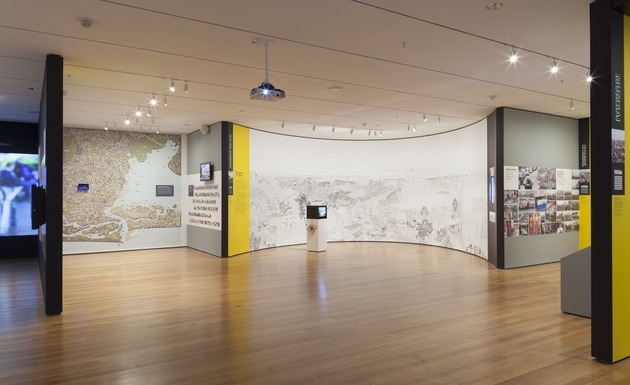
In the exhibition catalogue, Gadanho and several other internationally influential curators and urban thinkers (including Barry Bergdoll, Ricky Burdett, Teddy Cruz, Saskia Sassen, and Nader Tehrani) frame the understanding of tactical urbanism that grounds the exhibition. They offer a variety of contextual reflections and interpretative formulations to explicate its essential elements. Amid disparate orientations and concerns, a number of points of convergence emerge:
• Tactical urbanism arises in the context of a broader governance crisis in contemporary cities in which both states and markets have failed systematically to deliver basic public goods (such as housing, transportation and public space) to rapidly expanding urban populations.
• Tactical urbanism is not a unified movement or technique, but rather a general rubric through which to capture a broad range of emergent, provisional, experimental, and ad hoc urban projects.
• Tactical urbanism is mobilized from below, through organizationally, culturally, and ideologically diverse interventions to confront emergent urban issues. Professional designers, as well as governments, developers, and corporations may participate in and actively stimulate tactical urbanism. But its generative sources lie outside the control of any clique of experts or any specific institution, social class, or political coalition.
• Tactical urbanism proposes immediate, “acupunctural” modes of intervention in relation to local issues that are viewed as extremely urgent by its proponents. Its time horizon is thus relatively short, even impulsive or spontaneous. Likewise, its spatial scale tends to be relatively circumscribed—for instance, to the park, the building, the street or the neighborhood.
• Specific projects of tactical urbanism are said to evolve fluidly in relation to broader shifts in political-economic conditions, institutional arrangements, or coalitional dynamics. These qualities of malleability and open-endedness are widely praised in discussions of tactical urbanism, generally in contrast to the comprehensive plans, formal legal codes, and rigid blueprints that were characteristic of modernist-statist projects of urban intervention.
• Tactical urbanism generally promotes a grassroots, participatory, hands-on, do-it-yourself vision of urban restructuring, in which those who are most directly affected by an issue actively mobilize to address it, and may continually mobilize to influence the evolution of methods and goals. For this reason, tactical urbanism is often presented as an open-source model of action and as a form of reappropriation of urban space by its users.
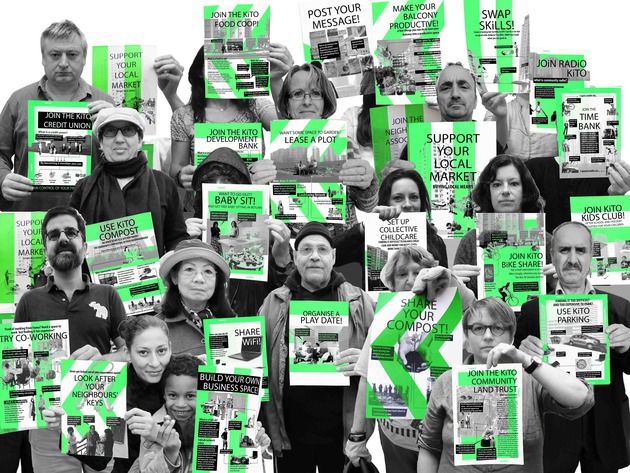
Most of the commentators involved in Uneven Growth present tactical urbanism as an alternative to both modernist-statist and neoliberal paradigms of urban intervention—because, for instance, it is grounded upon participatory democracy; it aims to promote social cohesion; and it is not formally preprogrammed in advance or from above. However, it is the opposition of tactical urbanism to modernist, comprehensive forms of urban planning that is most cogently demarcated in the wide-ranging narratives associated with the exhibition. Modernist-statist modes of urban intervention, it is argued, have receded due to the ideological ascendancy of neoliberalism and the associated “disassembling of nation-states” (Saskia Sassen) since the 1980s. To the degree that some elements and offshoots of that tradition are still being mobilized in the megacities of the developing world via holistic, comprehensive planning and “top-down action,” they are often “entangled in inefficient politics, corrupt bureaucracy, and economic insufficiency” (Pedro Gadanho). Tactical urbanism is thus presented as a potential palliative for urban problems that state institutions and formal urban planning procedures, in particular, have failed to address adequately.
Despite the affirmations of many of the contributors to Uneven Growth, it is less obvious how the projects associated with tactical urbanism could counteract neoliberal urbanism. Especially in light of the stridently anti-planning rhetoric that pervades many tactical urban interventions and their tendency to privilege informal, incremental, and ad hoc mobilizations over larger-scale, longer-term, publicly financed reform programs, it seems reasonable to ask in what ways they do, in actuality, engender any serious friction against the neoliberal order, much less subvert it.5The key text on neoliberal forms of urban governance remains David Harvey’s classic essay, “From Managerialism to Entrepreneurialism: The Transformation in Urban Governance in Late Capitalism,” Geografiska Annaler, Series B 71, no. 1 (1989): 3–17. See also Neil Brenner and Nik Theodore, “Cities and the Geographies of ‘Actually Existing Neoliberalism,’” Antipode 34, no. 3 (2002): 349–79; and Jamie Peck and Adam Tickell, “Neoliberalizing Space,” Antipode 34, no. 3 (2002): 380–404. In some cases, tactical urbanisms appear more likely to bolster neoliberal urbanisms by temporarily alleviating (or perhaps merely displacing) some of their disruptive social and spatial effects, but without interrupting the basic rule-regimes associated with market-oriented, growth-first urban development, and without challenging the foundational mistrust of governmental institutions that underpins the neoliberal project. The relation between tactical and neoliberal forms of urbanism is thus considerably more complex, contentious, and confusing than is generally acknowledged in the contributions to the debate on Uneven Growth. As illustrated in the list below, it cannot be simply assumed that because of their operational logics or normative-political orientations, tactical interventions will, in fact, counteract neoliberal urbanism. No less than five specific types of relation between these projects can be readily imagined, only two of which (1 and 5 in the list) might involve a challenge to market-fundamentalist urban policy. There are at least three highly plausible scenarios in which tactical urbanism will have either negligible or actively beneficial impacts upon a neoliberalized urban rule-regime.
- Subversion. Tactical urbanism interrupts the basic logics of growth-first, market-oriented urban governance and points toward alternative urban futures based on grassroots democracy and social justice.
- Reinforcement. Tactical urbanism alleviates some of the governance failures and disruptive socio-spatial consequences of neoliberal urbanism, but without threatening its grip on the regulatory framework governing urban development.
- Entrenchment. Tactical urbanism internalizes a neoliberal agenda (for instance, related to a diminished role for public institutions and/or an extension of market forces) and thus contributes to the further entrenchment and extension of neoliberal urbanism.
- Neutrality. Tactical urbanism emerges in interstitial spaces that are neither functional to, nor disruptive of, the neoliberal project. It thus coexists with neoliberal urbanism in a relationship that is neither symbiotic, parasitic, nor destructive.
- Contingency. Tactical urbanism opens up a space of regulatory experimentation that, under certain conditions, contributes to the subversion of neoliberal programs. But, in other contexts, with many of the same conditions present, this does not occur. The impacts of tactical urbanism on neoliberal urbanism are thus contingent; they hinge upon factors extrinsic to it.
Tactical urbanism may be narrated as a self-evident alternative to neoliberal urbanism; but we must ask the question: is this really the case, and if so, how, where, under what conditions, via what methods, with what consequences, and for whom? Clarification of these (undeniably tricky) issues is essential to any serious consideration of the potentials and limits of tactical urbanism under contemporary conditions. Neoliberal urbanism, it should be emphasized, is not a unified, homogenous formation of urban governance, but rather represents a broad syndrome of market-disciplinary institutions, policies, and regulatory strategies.6See Neil Brenner, Jamie Peck, and Nik Theodore, “Variegated Neoliberalization: Geographies, Modalities, Pathways,” Global Networks 10, no. 2 (2010): 182–222; Neil Brenner, Jamie Peck, and Nik Theodore, “After Neoliberalization?,” Globalizations 7, no. 3 (2010): 327–45; Jamie Peck, Nik Theodore, and Neil Brenner, “Postneoliberalism and Its Malcontents,” Antipode 41, no. 1 (2009): 94–116; and Jamie Peck, Nik Theodore, and Neil Brenner, “Neoliberalism Resurgent? Market Rule after the Great Recession,” South Atlantic Quarterly 111, no. 2 (2012): 265–88. While certainly connected to the ideology of free market capitalism, this syndrome has assumed deeply variegated political, organizational, and spatial forms in different places and territories around the world, and its politico-institutional expressions have evolved considerably since the global economic crises and accompanying geopolitical shocks of the 1970s. Across all the contextual diversity and evolutionary mutation, however, the common denominator of neoliberal urbanisms is the market-fundamentalist project of activating local public institutions and empowering private actors and organizations to extend commodification across the urban social fabric, to coordinate a city’s collective life through market relations, and to promote the enclosure of non-commodified, self-managed urban spaces.
As Teddy Cruz succinctly notes in his contribution to the Uneven Growth catalogue, all this has promoted the “shift from urbanizations benefitting the many into models of urban profit for the few.”7Teddy Cruz, “Rethinking Uneven Growth: It’s About Inequality, Stupid,” in Gadanho, Uneven Growth, 51. Whereas the idea of “urbanizations benefitting the many” broadly corresponds to the now-discredited megaprojects and programming techniques of statist modernism, the promotion of “urban profit for the few” has been the predominant tendency since the 1980s, at once in the older capitalist world, the former state socialist world, and across most of the postcolonial and developing world. Despite plenty of interterritorial variegation, societal resistance, political contestation, and reregulatory pushback, this tendency has persisted, and even intensified, through the many waves of industrial restructuring and financial crisis that have ricocheted across every zone of the world economy since that period, including since the most recent “Great Recession” of the last half decade. The patterns of “uneven growth” that are under scrutiny in the MoMA exhibition must be understood as its direct expressions and outgrowths. Nader Tehrani productively underscores this fundamental point in his contribution to the exhibition catalogue, asking whether conditions in contemporary megacities result less from earlier design mishaps, explosive population growth, or brute physical expansion than from “the lack of policies that are the preconditions for social welfare: access to education, health, and shelter.”8Nader Tehrani, “Urban Challenges: Specifications of Form and the Indeterminacy of Public Reception,” in Gadanho, Uneven Growth, 60.
It is, then, neither the contemporary urban condition as such, nor the inefficiencies of postwar, modernist-statist urban planning, that have most directly triggered the situations and problems to which contemporary forms of tactical urbanism are responding. Rather, contemporary tactical urbanisms are emerging in contexts that have been powerfully ruptured and reshaped by historically and geographically specific forms of neoliberal urbanization, based on the class project of restricting “the right to the city” (Henri Lefebvre) to the wealthy, the elite, and the powerful, and reorienting major public investments and policy regimes in ways that prioritize that project above all others.9Brenner and Theodore, “Cities and the Geographies of ‘Actually Existing Neoliberalism.’” See also David Harvey, A Brief History of Neoliberalism (New York: Oxford University Press, 2007). Despite its pervasive governance failures, its powerfully destructive socio-environmental consequences, and its increasingly evident ideological vulnerabilities, neoliberalism continues to represent the taken-for-granted common sense on which basis urban development practice around the world is still being forged. The question of how designers might contribute to alternative urban futures must thus be framed most directly—and, from my perspective, a lot more combatively—in relation to the apparent resilience and elasticity of neoliberal forms of urban governance.
One important consequence of these observations is the proposition that the architectural and design disciplines could significantly enhance their capacity to make durable, progressive urban interventions by engaging more systematically with questions of institutional (re)design—that is, the systems of collectively binding rules that govern the production, use, occupation, and appropriation of space.10For a parallel argument, see Jerold Kayden, “Why Implementation Matters,” Harvard Design Magazine 37 (2014): 57-59. The latter are arguably as essential to the broad visions for future megacities proposed in Uneven Growth as the tactical, acupunctural projects of infrastructural and physical reorganization with which the bulk of the exhibition is concerned. Indeed, in the absence of an aggressively reasserted role for governmental institutions—publicly funded through an equitable and fair tax regime; democratically legitimated and publicly accountable; legally regulated and transparently monitored; and oriented toward the public interest—it is difficult to imagine how the tactical urbanist proposals put forward in Uneven Growth could ever attain the larger-scale, longer-term impacts with which the exhibition’s contributors are concerned.
Herein lies a potentially serious contradiction. The anti-statist, anti-planning rhetoric of many tactical urbanist interventions may, in practice, significantly erode their capacity to confront the challenges of upscaling their impacts. To the degree that advocates of tactical urbanism frame their agenda as an alternative to an activist role for public institutions in the production of urban space, they are at risk of reinforcing the very neoliberal rule-regimes they ostensibly oppose. This is in no way to suggest that tactical urbanist projects should ignore the serious deficits of state action in contemporary megacities. On the contrary, the critique of how market-oriented state policies (including privatization, deregulation, and liberalization) erode public institutions in favor of privatized forms of urban appropriation is essential to any counter-neoliberal, reregulatory project.11Brenner and Theodore, “Cities and the Geographies of ‘Actually Existing Neoliberalism.’” and Peck and Tickell, “Neoliberalizing Space.” Just as important, in this context, is the collective demand for more extensive public support for key dimensions of social reproduction—the essential infrastructures associated with housing, transportation, education, public space, health care, and so forth.12Highly salient on such issues is Robert Lake, “Bring Back Big Government,” International Journal of Urban and Regional Research 26, no. 4 (2002): 815–22. The point here, then, is simply that there are deep tensions between the project of finding viable alternatives to neoliberal urbanism and a tradition of urban intervention that tends to distance itself from state institutions.
In his contribution to the Uneven Growth catalogue, Teddy Cruz offers a hard-hitting formulation of the major challenges associated with that endeavor among architects and designers:
Without altering the exclusionary policies that have decimated a civic imagination in the first place, architecture will remain a decorative tool to camouflage the neoconservative politics and economics of urban development that have eroded the primacy of public infrastructure worldwide [ . . . ] the major problems of urbanization today [ . . . ] are grounded in the inability of institutions of urban development to more meaningfully engage urban informality, socioeconomic inequity, environmental degradation, lack of affordable housing, inclusive public infrastructure, and civil participation.13Teddy Cruz, “Rethinking Uneven Growth,” 51.
This is precisely the dilemma: how can tactical urbanisms do more than serve as “camouflage” for the vicissitudes, dislocations, and crisis-tendencies of neoliberal urbanism? Cruz’s formulation underscores one of the key conditions under which it might begin to do so: through the re-imagination of design, not simply as a decorative tool or formal set of techniques for hire by the ruling classes, but as a basis for asking critical questions about contemporary urbanism, and as a set of collectively shared, creative capacities through which to “coproduce the city as well as new models of cohabitation and coexistence to advance agendas of socioeconomic inclusion.”14Ibid, 51. This goal cannot be realized simply through the redesign and reappropriation of specific physical sites within the city; it also requires the creation of “a new role for progressive policy, [and] a more efficient, transparent, inclusive, and collaborative form of government.”15Ibid, 55. In other words, the pursuit of alternative urbanisms requires the creation not only of new urban spaces, but of new state spaces as well.
These considerations yield a critical perspective from which to examine some of the design proposals for contemporary megacities that are on display in MoMA’s Uneven Growth. MoMA curator Gadanho’s remit to the six design teams was not only to propose a tactical intervention for a specific megacity—“acupunctural outlooks on how change for the better could be induced in diverse urban contexts”—but, in so doing, to offer a new perspective on what a socially engaged architecture might look like, today and in the future. We must thus consider the exhibition materials at once as possible scenarios for a future urbanism, and as visions of how the design disciplines might use tactical approaches to contribute to their realization. Gadanho emphasizes that the exhibition’s goal is not to offer immediate solutions to current urban problems, but to put forward broader, speculative visions that might “fuel the public debate on those issues.” At the same time, he quite appropriately emphasizes the need for scalability, that is, the prospect of a trans-local application of progressive, tactical ideas—“solutions that could be replicated in different contexts.” Even if they harness the speculative capacities of design, then, the proposals on display in the exhibition are clearly not meant to be pure fictions—they are presented as critical tools “to reflect upon the problems of today.”16Gadanho, “Mirroring Uneven Growth,” various quotes drawn from 23, 16.
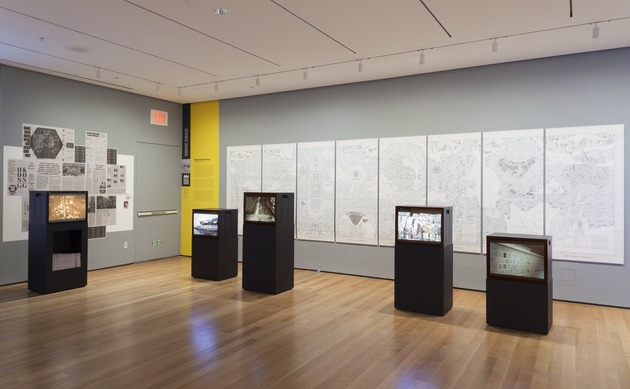
My own impression is that only some of the design proposals featured in the exhibition respond effectively to this remit. While the exhibition’s theorists broadly agree on the contours of a tactical urbanism, there is evidently considerable confusion, or perhaps simply divergence, regarding the meaning and implications of this notion among the designers themselves. Although all of the design scenarios are presented under the shared rubric of tactical urbanism, some bear little resemblance to an acupunctural, participatory, open-sourced intervention. Indeed, several of the design proposals presented in Uneven Growth involve large-scale megaprojects and landscape transformations that could presumably only be implemented through a powerful, well-resourced state apparatus; they are difficult to envision as more than partial outgrowths of tactical methods. Meanwhile, other design proposals are consistently framed within tactical parameters, but yield a vision of the urban future that appears entirely compatible with most versions of neoliberalism. Such interventions may respond effectively to the speculative questions about the future of megacities that were posed to the design teams, but they bypass the intricacies of exploring real alternatives to the currently dominant system of market rule.
A number of the proposals circumvent questions of implementation entirely. Building upon local research endeavors and associated visualizations, they put forward relatively decontextualized design “solutions” to the pressing problems of megacity development—for instance, regarding water scarcity, insufficient land for housing, transportation bottlenecks, or issues of energy supply. Indeed, several of the proposals may be more readily classified within the rather familiar genre of dystopian design fantasies and technological prophecies in relation to which exhibition curator Gadanho proposes to distinguish the more socially oriented, ethically motivated MoMA project. Because they bracket the formidable constraints associated with implementation under a neoliberalized rule-regime, these design scenarios remain at a purely hypothetical level—visions of an alternative universe that are utopian in the literal sense of that word; they are located nowhere. They put the capacities of design thinking on display, often with striking visual flourishes, but with considerably less traction than if the conditions for their potential actualization were more seriously interrogated. Such proposals may well have other merits—for instance, as creative engagements with specific megacity environments and as contributions to global architectural culture. However, viewers who seek in Uneven Growth some intellectual and practical resources for elaborating alternatives to neoliberal urbanism are unlikely to find these offerings particularly salient to their concerns.
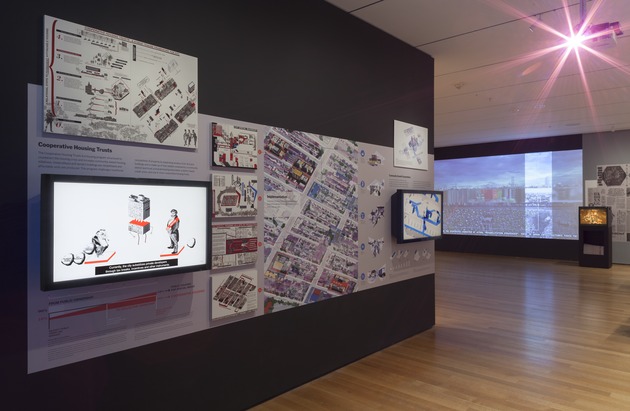
Among the contributions to Uneven Growth that most directly attempt to mobilize tactical interventions as part of a broader assault on neoliberal urbanism, the scenarios elaborated by the Mumbai design team (URBZ/Ensamble-POP lab), the Istanbul design team (Atelier d’Architecture Autogérée/ Superpool) and one of the New York City teams (Cohabitation Strategies— CohStra) are particularly generative. Notably, each does so through an engagement with the housing question, which has been a fundamental terrain of design intervention and political struggle throughout the history of capitalist urbanization, and which certainly remains so in the age of the “planet of slums.” In confronting this well-trodden terrain, the teams illustrate how an expanded vision of design—as a set of combined capacities for spatial intervention, social empowerment, and political critique—can contribute to the ongoing struggle for alternative urbanisms.
The Mumbai proposals by URBZ/Ensamble-POP lab mobilize tactical interventions to protect so-called slum neighborhoods such as Dharavi and Shivaji Nagar from the massive land-development pressures associated with Mumbai’s extensively neoliberalized, financialized economy. This is a multifaceted proposal, perhaps reflecting the different positionalities of the project teams relative to the slum itself (URBZ is a group of activist-designers with strong roots in Mumbai’s poor neighborhoods, whereas the POPlab is based at the Massachusetts Institute of Technology). At core, the project presents a series of incremental design strategies to promote an alternative vision of the “slum” as a space of productivity, creativity, and ingenuity—a “tabula pronta,” in the team’s formulation, rather than a tabula rasa that can be readily razed to make room for new zones of single-function mass housing. Instead of imposing a new prototype from outside, the designers propose to enhance spatial practices that already animate those neighborhoods—specifically, the integration of residential spaces with work spaces or “tool houses.” By supplying a model of “up-building” that enables residents to construct new platforms for work and everyday life above their homes, and by creating a network of “supraextructures” on a plane stretched like a magic carpet above the rooflines, new possibilities for endogenous local economic development and social interaction are envisioned. The developmental potentials thus unleashed would, the designers propose, serve as strong counterpoints to dominant ideologies of the slum as a space of backwardness and pathology, while also stimulating the elaboration of a less polarized growth pattern across the metropolitan fabric.
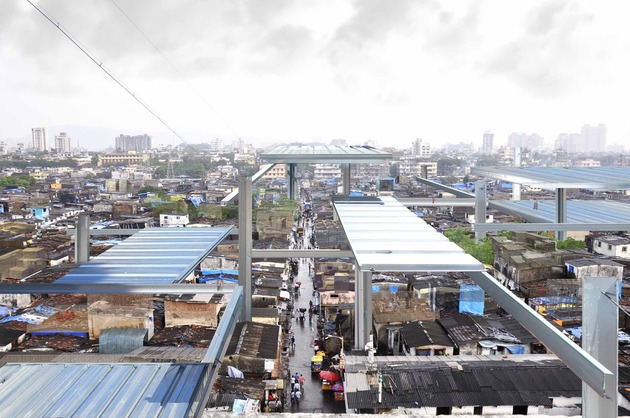
Thorny questions remain, of course, regarding the degree to which the proposed tactical interventions could, in themselves, protect the most strategically located neighborhoods from land-development pressures, especially in the absence of a broader political movement that questions the model of market-driven urban growth to which Mumbai’s growth coalition committed itself following the liberalization of the Indian economy in the 1990s. Through what institutional mechanisms and political coalitions could tenure security be attained by slum dwellers living in zones of the city that are considered attractive by growth-machine interests? As radical geographer Neil Smith pointed out some time ago, when local-government institutions align with development interests to exploit such a “rent gap” in the urban land market, organized resistance is likely to be met with considerable vilification, if not outright repression.17Neil Smith, The New Urban Frontier (New York: Routledge, 1996). There is no doubt, however, that design has a fundamental role to play in defending vulnerable populations and neighborhoods against further disempowerment, dispossession, and spatial displacement. The proposal for Mumbai by URBZ/Ensamble-POP lab very productively puts this issue on the exhibition’s agenda. It will hopefully inspire other designers to take up this project in other megacities, in collaboration with local inhabitants, local social movements, and nongovernmental organizations that share their concerns.18For further details on the URBZ team’s ongoing work in Dharavi, and their powerful critique of the various developmentalist ideologies associated with what they term “the slum narrative,” see their recently published e-book with Strelka Press.
While the design proposals presented by the Istanbul and New York teams contain important architectural/morphological elements (pertaining, for instance, to buildings, infrastructures, and neighborhood districts), their creative radicalism is strongly rooted in models for new institutional arrangements that would empower each city’s low- or middle-income inhabitants to occupy, appropriate, and regenerate spaces that are currently abandoned, degraded. or being subjected to new forms of vulnerability. In the New York context, the CohStra team focuses on a variety of interstitial or underutilized spaces in the city core—from vacant lots and abandoned buildings to various kinds of lower-density housing provision—in order to propose an alternative framework for land ownership (community land trusts), housing provision (mutual housing associations), building management (cooperative housing trusts), and household financing (community credit unions). In the case of Istanbul, the Atelier d’Architecture Autogérée’s design proposal targets the mass housing complexes that were constructed for the burgeoning middle classes during the post-1990s period by Turkey’s Housing Development Agency, known as TOKI, which are predominantly located in more peripheral districts within Istanbul’s rapidly urbanizing metropolitan territory. Here, the designers propose to retrofit existing TOKI housing ensembles, and their immediate landscapes, in ways that facilitate new forms of communal self-management by the inhabitants—including, as with CohStra’s proposal for New York, community land trusts and local credit unions, along with other forms of collectively managed infrastructure, such as community farming and gardens, fisheries, workshops, green-energy sources, and repair facilities.
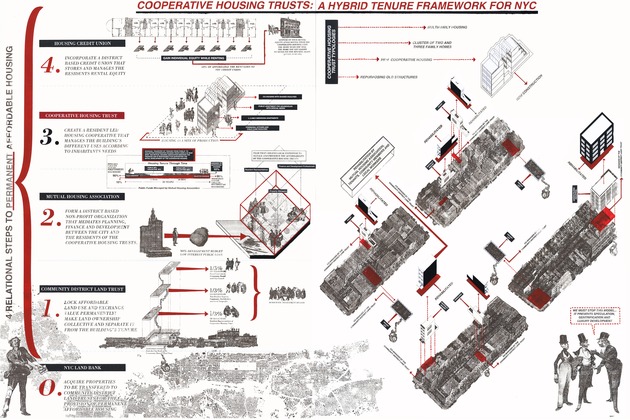
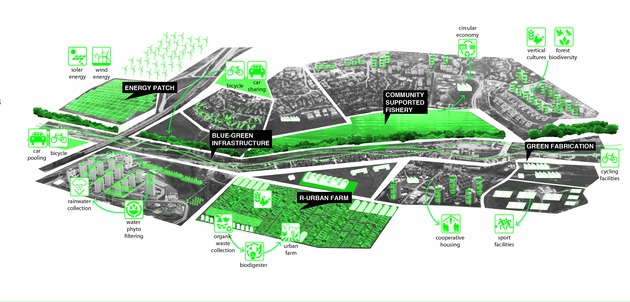
As with the Mumbai team’s proposal, each of these tactical interventions is framed as a response to a specific, immediate set of threats to urban life that have been imposed by the neoliberal growth model in the city under consideration—the “crisis of affordability” for working New Yorkers; and the destabilization of the model of middle-class consumerism that had been promoted in Istanbul through TOKI mass housing. Notably, however, CohStra and the Atelier d’Architecture Autogérée move beyond a defensive posture in relation to such issues, offering instead a vision of how the spaces that are being degraded under neoliberalized urbanism could become the anchors for an alternative vision of the city as a space of common life and collective self-management. In both projects, the site of design intervention is viewed as a commons, a space of continuous, collective appropriation and transformation by its users. Both teams offer a vision of this commons as a process to which designers can contribute in fundamental ways, not only by elaborating spatial proposals for the reorganization of housing functions or other dimensions of social reproduction, but also by reimagining how such basic institutions as private property, profit-oriented real-estate investment, urban land markets, and municipal bureaucracy might be transformed and even superseded to serve social needs, to empower urban inhabitants, and to contribute to the creation of a genuine urban public sphere.
Although the Istanbul and New York projects are presented in tactical terms, they are clearly intended as more than fleeting acupunctural interventions. Part of their appeal, from my point of view, is precisely that they offer a model of tactical urbanism that may be aggressively upscaled and converted into a city-wide counterforce to the neoliberal model. Initially offering a kind of protected enclave for a vulnerable population, each project is then meant to be transformed into a generalizable alternative to the specific forms of housing commodification and accumulation by dispossession that have underpinned and exacerbated “uneven growth” in their respective megacities. To my mind, it is this reflexive attempt to connect the methods of tactical urbanism to a double-edged redesign of urban spaces and institutions that makes these teams’ proposals effective as tools for envisioning alternatives to the neoliberal city. In thus proceeding, however, the proposals by the Atelier d’Architecture Autogérée and CohStra rather quickly move beyond the realm of tactical urbanism: rather than being a focal point for investigation as such, the latter becomes a kind of launching pad for envisioning and enacting a “politics of space” (Henri Lefebvre)—that is, a political strategy of large-scale socio-spatial transformation.
Here, too, of course, the inevitable questions of implementation loom on the immediate horizon. How can this vision of the commons (and of commoning practices) be realized when the dominant class interests and political alliances in each megacity continue to promote a profit-oriented, speculation-driven growth model? Where are the social forces and political coalitions that could counteract that model, and would they really opt for the level of collective coordination and communal sharing proposed by these design teams? How can local alternative economies be protected from incursions by profit-oriented producers, who may (for instance, through economies of scale, or more rationalized forms of labor exploitation) be able to offer more affordable or desirable products to cash-strapped consumers? Designers cannot answer these questions, at least, not among themselves; they can only be decided through political deliberation, public debate, and ongoing struggle. But, because CohStra and the Atelier d’Architecture Autogérée took the fundamental step of integrating such political-institutional considerations into their spatial proposals, they productively contribute to that process. Just as importantly, given the remit of the MoMA curatorial team, their proposals also articulate a more socially engaged, politically combative vision of what the design disciplines have to offer the urban public sphere in an era of deepening inequality and highly polarized visions of our global urban future.
Given the difficulties that some of the design teams appear to have had with the tactical urbanism framework, one cannot help but wonder whether it offered them too narrow a terrain, or too limited a tool kit, for confronting the vast, variegated challenges that are currently emerging in the world’s megacities. In his preface to the exhibition catalogue, MoMA curator Barry Bergdoll anticipates this conundrum, noting the gap between the “modest scale of some [tactical] interventions” and the “dimensions of the worldwide urban and economic crisis that so urgently needs to be addressed.”19Bergdoll, “Preface,” in Gadanho, Uneven Growth, 12. In the face of these challenges, one can hardly reproach the teams that opted to venture forth with big, ambitious proposals rather than restricting themselves to mere “tactics.”
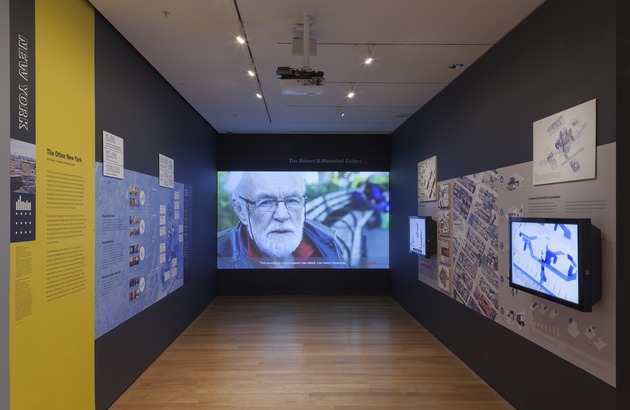
But here arises a further contradiction of the Uneven Growth project. A pure form of tactical urbanism would have to be systematically anti-programmatic; it could only maintain a consistently tactical approach by resisting and rejecting any movement toward institutionalization.20In his writings on the right to the city and autogestion in the 1970s, radical urban theorist Henri Lefebvre wrestled repeatedly with an earlier version of this dilemma. See, among other texts, “The Right to the City,” in Henri Lefebvre, Writings on Cities, eds. Eleonore Kofman and Elizabeth Lebas (Blackwell: Cambridge, 1996 [1968]) and Henri Lefebvre, State, Space, World: Selected Writings, eds. Neil Brenner and Stuart Elden (Minneapolis: University of Minnesota Press, 2009). Yet, to the degree that the tactical design experiments on display in Uneven Growth articulate a broader vision of urbanism and urban transformation, they necessarily hinge upon the (eventual) articulation of a comprehensive vision of the whole. The generalization of tactical urbanism will thus entail its self-dissolution or, more precisely, its transformation into a project that requires longer-term coordination; stabilized, enforceable, collectively binding rules; and some kind of personnel assigned to the tasks of territorial management—in other words, planning. We thus return to the supposedly discredited, outmoded terrain of statist modernism, the realm of big ambitions, large-scale blueprints, elaborate bureaucratic procedures, and comprehensive plans, in opposition to which the precepts of tactical urbanism are generally framed. Even if one prefers tactical methods over those of top-down bureaucracies (or, for that matter, those of profit-hungry developers and transnational corporations), it would seem that a serious discussion of large-scale territorial plans, institutional (re)organization, and political strategies of implementation is unavoidable, at least if the goal is seriously to envision a future for megacities that is more socially and spatially just, democratic, livable, and environmentally sane than our present global urban condition.
For anyone sympathetic to tactical urbanism and the project of large-scale, progressive urban transformation, this contradiction is probably unavoidable. Can it be made productive, and even affirmed? Perhaps the radical potential of tactical urbanism lies less in its role as an all-purpose method for designing urban futures, than as a radically democratic counterweight to any and all institutional systems, whether state driven or market dominated. Some of the most valuable contributions in MoMA’s Uneven Growth serve precisely this purpose: they point toward the possibility that, rather than being instrumentalized for social engineering, political control, private enjoyment, or corporate profit making, the capacities of design might be remobilized as tools of empowerment for the users of space, enabling them to occupy and appropriate the urban, continually to transform it, and thus to produce a different city than anyone could have dreamt up in advance.
But even in this maximally optimistic framing of tactical urbanism, the big questions regarding how to (re)design the city of the future—its economy; its property and labor relations; its spaces of circulation, social reproduction, and everyday life; its modes of governance; its articulations to worldwide capital flows; its interfaces with environmental/biophysical processes; and so forth—remain completely unresolved. As MoMA’s Department of Architecture and Design continues its productive engagement with urbanism, let us hope that such questions will stay on the agenda, and that the creative capacities of designers can be harnessed to confront them with all the critical force, political imagination, and systematic vision they require.
- 1David Harvey, “The Crisis of Planetary Urbanization,” in Pedro Gadanho, ed., Uneven Growth: Tactical Urbanisms for Expanding Megacities (New York: The Museum of Modern Art, 2014), 29.
- 2On “wicked problems” in urban planning, see Horst Rittel and Melvin Webber, “Dilemmas in a General Theory of Planning,” Policy Sciences 4 (1973): 155–69.
- 3See Barry Bergdoll, “Preface,” and Pedro Gadanho, “Mirroring Uneven Growth: A Speculation on Tomorrow’s Cities Today,” in Gadanho, Uneven Growth, 11–25.
- 4Gadanho, “Mirroring Uneven Growth,” 23.
- 5The key text on neoliberal forms of urban governance remains David Harvey’s classic essay, “From Managerialism to Entrepreneurialism: The Transformation in Urban Governance in Late Capitalism,” Geografiska Annaler, Series B 71, no. 1 (1989): 3–17. See also Neil Brenner and Nik Theodore, “Cities and the Geographies of ‘Actually Existing Neoliberalism,’” Antipode 34, no. 3 (2002): 349–79; and Jamie Peck and Adam Tickell, “Neoliberalizing Space,” Antipode 34, no. 3 (2002): 380–404.
- 6See Neil Brenner, Jamie Peck, and Nik Theodore, “Variegated Neoliberalization: Geographies, Modalities, Pathways,” Global Networks 10, no. 2 (2010): 182–222; Neil Brenner, Jamie Peck, and Nik Theodore, “After Neoliberalization?,” Globalizations 7, no. 3 (2010): 327–45; Jamie Peck, Nik Theodore, and Neil Brenner, “Postneoliberalism and Its Malcontents,” Antipode 41, no. 1 (2009): 94–116; and Jamie Peck, Nik Theodore, and Neil Brenner, “Neoliberalism Resurgent? Market Rule after the Great Recession,” South Atlantic Quarterly 111, no. 2 (2012): 265–88.
- 7Teddy Cruz, “Rethinking Uneven Growth: It’s About Inequality, Stupid,” in Gadanho, Uneven Growth, 51.
- 8Nader Tehrani, “Urban Challenges: Specifications of Form and the Indeterminacy of Public Reception,” in Gadanho, Uneven Growth, 60.
- 9Brenner and Theodore, “Cities and the Geographies of ‘Actually Existing Neoliberalism.’” See also David Harvey, A Brief History of Neoliberalism (New York: Oxford University Press, 2007).
- 10For a parallel argument, see Jerold Kayden, “Why Implementation Matters,” Harvard Design Magazine 37 (2014): 57-59.
- 11Brenner and Theodore, “Cities and the Geographies of ‘Actually Existing Neoliberalism.’” and Peck and Tickell, “Neoliberalizing Space.”
- 12Highly salient on such issues is Robert Lake, “Bring Back Big Government,” International Journal of Urban and Regional Research 26, no. 4 (2002): 815–22.
- 13Teddy Cruz, “Rethinking Uneven Growth,” 51.
- 14Ibid, 51.
- 15Ibid, 55.
- 16Gadanho, “Mirroring Uneven Growth,” various quotes drawn from 23, 16.
- 17Neil Smith, The New Urban Frontier (New York: Routledge, 1996).
- 18For further details on the URBZ team’s ongoing work in Dharavi, and their powerful critique of the various developmentalist ideologies associated with what they term “the slum narrative,” see their recently published e-book with Strelka Press.
- 19Bergdoll, “Preface,” in Gadanho, Uneven Growth, 12.
- 20In his writings on the right to the city and autogestion in the 1970s, radical urban theorist Henri Lefebvre wrestled repeatedly with an earlier version of this dilemma. See, among other texts, “The Right to the City,” in Henri Lefebvre, Writings on Cities, eds. Eleonore Kofman and Elizabeth Lebas (Blackwell: Cambridge, 1996 [1968]) and Henri Lefebvre, State, Space, World: Selected Writings, eds. Neil Brenner and Stuart Elden (Minneapolis: University of Minnesota Press, 2009).




